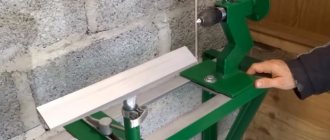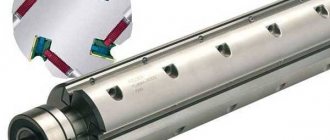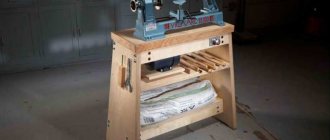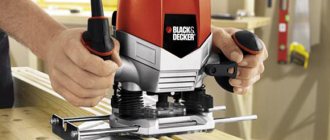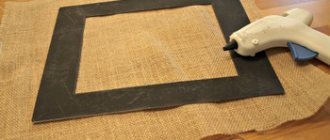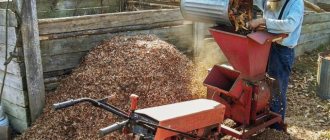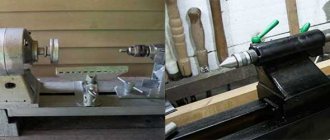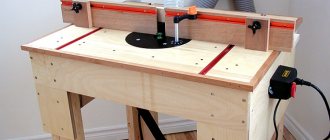Structure and principle of operation of a slotting machine
A homemade slotting machine consists of the following main parts:
- base on which a movable platform is installed for fastening joinery blanks,
- electric motor with power up to 2 kW,
- shaft - at one end a belt drive is installed to the engine, at the other - a chuck for an actuating rotating tool (cutter, drill, milling cutter),
- parts holders, vices,
- levers for raising/lowering and adjusting the movement of the stand,
- on/off button,
- additional options, depending on work tasks.
The operating principle of a homemade slotting unit is based on the reciprocating movement of a rotating drilling and slotting tool. The process of making holes in wooden parts occurs according to the following scheme:
- the workpiece is mounted on a stand and securely secured with a vice,
- the drill (cutter) is fixed in the shaft chuck, the motor starts,
- with a movable frame structure, the workpiece is fed to a drilling (slotting) tool, which makes a hole of the required parameters and configuration.
To obtain an elongated groove, the workpiece is moved perpendicular to the drill, the drilled holes are combined into a single sample. The stroke of the cutter, which can be adjusted, determines the sample size.
What types of machines are there?
In principle, the choice here is small; such equipment comes in two types:
- In large industries, centrifugal machines with a cutting chain are often used.
- For more modest scales or work at home, craftsmen use a wood slotting drill, which functions in a similar way to a milling cutter.
Professional equipment
The main element of a centrifugal machine is a special chain, consisting of individual links connected by a hinge. Each link has a sharply ground milling tooth.
The chain itself is tensioned on a guide bar, in the lower part of which a roller is installed, and the upper part of the bar is equipped with an asterisk, which actually drives the mechanism.
Diagram of a slotting machine with a chain.
The structure of such equipment is relatively simple. A movable support with an electric motor is mounted on a common frame and a table with a fixing mechanism is installed, into which the part is clamped. When the electric motor starts, rotation through a belt or gear drive is applied to the sprocket, which drives the chain.
Although the principle of operation is generally similar, there are machines on which the cutting is carried out using a movable support, with a stationary table. And machines in which the milling chain is fixedly fixed, and the table, in turn, is equipped with a roller slide driven by a mechanical or hydraulic system.
Machine with movable support.
Chain slotting machines for wood are characterized by resistance to loads and a significant service life. But the cross-section of the hole will strictly correspond to the cross-section of the chain, and to change it you need to change the chain itself.
Plus, when inserted into an array, the chain breaks off the edges of the hole, making them uneven. But this defect is inherent only in old equipment with an unstable clamping mechanism.
Photo of a milling type slotting machine.
Recommendations for choosing equipment
Industrial equipment must be distinguished not only by reliability, but also by serious functional content, so that in case of partial repurposing you do not have to buy a new machine.
You should pay attention to what angle the cutting head can be rotated, as well as the maximum possible degree of inclination of the slide. In addition, it is desirable that the working area be equipped with additional rotation mechanisms.
If the instructions contain instructions about the possibility of point-blank chiselling, then this indicates the presence of a device for working with large products and a serious cutting depth.
Professional slotting drills for wood.
Particular attention should be paid to the drive of the table or cutting head. Modern equipment is equipped only with electric or hydraulic drives
Mechanical models have been used before, and if you are offered a machine with such a drive, then it is either old or homemade.
Portable, portable equipment is not suitable for serious production with a large load. Such mechanisms are not designed for chiselling holes deeper than 100 mm; they will not be able to work continuously for a long time, plus their power leaves much to be desired. In fact, the main advantage here is the reasonable price.
If we briefly formulate the main set of factors that you need to pay attention to, it will look something like this:
Milling diagram.
- First of all, you should know the range of dimensions of the parts that are planned to be processed.
- Maximum and minimum depth, width, and cutting configuration.
- Starting and operating power of equipment.
- Availability of automatic overload protection and the ability to operate without mandatory grounding.
- The country plays an important role, as well as the name of the manufacturer. Sometimes it makes sense to take a less functional European than a “stuffed” Chinese.
Characteristics of slotting machines.
Do-it-yourself jointer (jointer)
Hello, dear readers and DIYers! Surely many of you would like to have at least a small jointing machine in your workshop. In this article, the author of the YouTube channel “Amazing Woodworking Techniques” will tell you how he implemented this project in a fairly simple way.
This homemade product is very easy to make, but requires high precision processing of parts. It is quite simple to make, but you will need boards with high quality processing. Materials. — Pine pallet board — Sheet plywood — Spring — Wood screws, furniture nuts, screws, nuts, washers — PVA glue. Tools used by the author. — Electric plane — Safety pusher — Hand router — Circular saw — Screwdriver — Countersink drill — Square, pencil, ruler, wrench, screwdriver, hammer. Manufacturing process. First of all, the master marks the contours of the electric plane on a pine board.
The author cuts off the excess material on a homemade circular table with a carriage.
He makes grooves for the engine housing and other technological recesses using a milling machine.
The result is a platform on which the plane itself sits
It is extremely important that the top of the board is perfectly level
To attach the tool to the table itself, the master secures its back with two stands and a bolt passed through the hole for the handle. After aligning the stands, they are screwed to the table with self-tapping screws from the bottom side.
Now the table itself can be attached to the supports using long self-tapping screws, having previously drilled pilot holes and countersinked them.
So, the basic design of the machine is very simple and is already ready.
The next step is to make a small support platform. It can be made from boards or plywood of suitable thickness, and fastened together using a couple of corners.
The support is attached to the outer part of the body, forming one plane with the adjustable platform.
After leveling and fixing with bolts, the plane of the soles and supports should be checked using a square or level. This must also be done along the diagonals.
It's time to install the side rip fence. The first part of it will be a pine beam. The master secures it with wing nuts, which will allow for subsequent adjustment.
And now the most important point is ensuring safe operation. To do this, a small wooden block is screwed to the second hole for the clamps.
A special protective petal is installed on this block, the axis of which will be an M8 bolt, at the end of which a transverse hole is drilled for attaching the spring tail. The bolt is firmly pressed against the petal, fixed on both sides with washers, and pressed with three nuts in the form of a stand.
The master places another washer between the nuts and the support block, and then installs the tension spring.
Having adjusted the required force of the spring, its second end is fixed with a self-tapping screw with a press washer to the bottom of the block.
Almost everything is ready, all that remains is to connect the general dust removal system, and you can start working. However, before this it is recommended to treat all surfaces with wood impregnation or polyurethane. For better sliding of parts on the table, you should use aerosol silicone lubricant.
So, the first thing the master takes for processing is an old pallet board. And the result is simply perfect.
And as a result, both the surfaces and the corners of the resulting timber have ideal geometric shapes.
To find nails in old pieces of wood, you can use the following tool. This thing can not only search for nails in wood, but also detect fittings and wiring in walls.
Follow safety regulations!
Become the author of the site, publish your own articles, descriptions of homemade products and pay for the text. Read more here.
Desktop device.
- Cut the machine base board (M) to size [Figure 4]. Screw the main supports (A) onto the machine base (M) from below. Install the swing arm (J) and control arm (I) [Figure 1, Photo H]. Place and secure the router in the stock [Photo I].
- Cut the mounting plates (N) to size and glue them to the base (M) [Figure 4]. Drill holes in the center of the mounting plates and install threaded bushings into them. Next, attach the control lever (H) to the mounting plate and connect it to the lever (L) [illustration of general view].
- Cut the bottom posts (P) and parts (OR) to the required size [Figure 4]. Use epoxy glue and screws to secure the bottom posts (P) to the machine base (M) [photo J]. Then, according to the dimensions of the grooves in the racks (P), prepare steel strips (R). Glue them into the grooves with epoxy resin.
- Pre-assemble the parts (P / Q / O) and drill through the holes for the bolts. Disassemble the parts and cut threads in the metal strips to the diameter of the bolts [Figure 4].
- Prepare thick and thin table spacers (S, T) according to size. In order for them to be easily inserted under the table into the bolts, it is necessary to make slots on them with a circular saw [Photos K and L]. Assemble a tabletop slotting and grooving machine. If the machine performs all the necessary functions, disassemble it, sand it and varnish the parts.
Important selection criteria
Choosing the right unit is not as simple as it might seem at first glance. There are several important parameters, the complex of which will allow you to purchase exactly the kind of tool that is needed for the manufacture of parts:
- machine power;
- the ability to adjust components, assemblies and equipment;
- dimensions of processing tools;
- the ability to move the processing tool in different directions, in three planes;
- maximum angle of inclination and speed of the cutter.
In addition to specialized parameters, you need to take into account the dimensions and weight of the product. The stability of the bed and ease of operation directly depend on them. The unit is equipped with additional devices and equipment. Good equipment significantly increases the functionality and productivity of a slotting machine.
Selection of metal slotting equipment
When choosing a slotting machine, there are a number of factors to consider. By acting in this way, you can guarantee a long service life of the equipment and its uninterrupted operation for a long time.
First of all, you should consider such a parameter as the permissible height of the parts for the device. It can have different values, which are determined primarily by the type of surface being processed.
Along with this, the declared power of the machine, the size of the cutter and the possibility of its regulation also deserve attention. It would be useful to inquire about the presence of transverse and longitudinal stroke of the device and the value of the permissible angle of inclination.
An important characteristic that determines the quality of work of a slotting machine is the speed of movement of the working tool. Only products that are equipped with a massive cabinet can demonstrate stability during operation.
This makes it possible to significantly simplify the processing of parts.
At the stage of choosing equipment, you should also take into account the size of the table, since this directly determines the ease of working with the device.
Types of machines
Equipment with this functionality can be divided into two categories:
- centrifugal slotting machines with a chain on the links of which slotting cutters are located. They are used in large woodworking plants and furniture factories;
- a device with a slotting head for a milling machine or similar analogues with a special drill, which are usually intended for doing work at home.
The main part of centrifugal devices with a cutter function is a cutting chain, on the links of which there are sharp slotting cutters for keyways. The design consists of a frame on which a movable support with an electric drive is fixed, as well as a work table with a special vice that clamps the workpiece. When the machine is turned on, the rotation from the gear is transmitted to the chain through a sprocket, which sets the cutting part in motion, thereby ensuring the chiselling of the groove. A drawing of the device is presented below.
There are slotting machines, the working table of which is in a static position, and the cut is performed by a movable support, and their analogues with a moving table on a roller mechanism, where the cutting chain is stationary. In this case, it can be a slotting machine with a mechanical drive or a hydraulic system (HD)
Please note that during longitudinal movement of the workpiece, the work is performed exclusively on a slotting machine with a moving table. The unit, which performs the chiselling of grooves using a drill, completely replicates in its structure a traditional milling machine, without which no furniture production or carpentry shop can do.
Selection rules
If you want to work with efficient and safe equipment, be sure to read its description when purchasing. Industrial designs must have a rich functional content, thanks to which it will be possible to mill and drill the surface being processed. Portable slotting machines of compact size are convenient to move from place to place, but they are not suitable for cutting grooves deeper than 100 mm and cannot operate continuously for a long time due to their low power.
Experienced craftsmen definitely recommend finding out how much the slotting head of the machine can rotate and what is the degree of inclination of the roller mechanism that regulates the position of the table. It is highly desirable that the mortising machine allows for point-blank slotting, as this function allows for deep cutting of large-sized lumber, if necessary. Of course, the richer the equipment, the higher its price. On modern models, the slotting head or bed is driven by an electric hydraulic motor, while mechanical samples belong to products of the previous generation.
There are several criteria that you should focus on when purchasing a grooving cutter
. First of all, you need to decide on the dimensions of the workpieces that will be processed on this unit. Of course, important indicators are the power, safety system and equipment that the slotting device has.
Varieties
The equipment in question can be classified according to many criteria, but they all have similarities, which led to the formation of two main groups:
- In production, where productivity is a fairly important indicator, a centrifugal woodworking slotting machine is used. As a rule, it is large in size and can be used to create various grooves.
- At home, you can use a manual slotting machine or a wood slotting drill. Such equipment works on the principle of a milling cutter.
A household wood slotting machine has a relatively simple design and low cost. However, an industrial grooving machine is often affordable only for large production organizations that carry out mass production.
Homemade machines
A homemade wood chisel is not that difficult to make if you really want to. Of course, it will be much inferior to its factory analogues, but it can handle standard wooden products for a summer house or home, plus the price of such an assistant is several times lower than its serial analogues.
Hand cutter for the machine.
It is most convenient to make a wood cutter using a hand cutter. Of course, in the absence of one, you can use an electric motor of appropriate power or a powerful electric drill, but in these cases you should not count on long-term and high-quality work, because they are not adapted to constant lateral load on the shaft.
Small platform for the cutter.
Initially, the router is rigidly mounted in a horizontal position. This way, during the work, we will be able to clearly see the cutter and the selected groove itself. Plus, with a horizontal stroke level, it is much easier to make a series of identical holes.
Assembly of components, side view.
Thick plywood from 10 mm is used as a basis. Platform dimensions vary depending on the dimensions of your router. The tool is installed strictly horizontally, level, the accuracy of the work performed depends on this. For rigid fixation, two identical bars are placed under the handles of the router, the entire structure is pressed with a metal pin, as in the photo.
Assembly of units, top view.
In principle, you can already work with such a device, but you will have to adjust the depth and size of the hole yourself. To ensure relative accuracy and the ability to make identical parts, a small improvement will be needed.
Lever device.
To ensure controlled transverse and longitudinal movement of the tool, you need to install 2 levers with a perpendicular guide vector. Provided that we already have a stationary frame, we will need another 1 sheet of larger plywood for arrangement.
Installation of platforms on the frame.
On a larger sheet, behind the platform with the router, a block with a lever is rigidly fixed. Another block is attached to the platform to movably fix the rod. The movement is carried out through the rod between the lever and the platform. Thus, we gain the ability to control depth.
Fixing the block with clamps.
To ensure transverse movement, a similar lever is fixed to the frame, only now it is connected by a rod to a large sheet and will move perpendicularly. Since plywood is a thin material, you will also have to secure a block for the rod on a larger sheet.
This device can be improved by installing guide slides made of thin wooden blocks. The above operating principle can be mirrored in table arrangements. In this case, the cutter will be stationary, and the selection will be carried out due to the movement of the table.
Homemade machine made from an electric motor.
The video in this article shows the operation of a slotting machine.
Creation sequence
If you have already found all the necessary materials, then you can start creating the machine. During production, we recommend following these instructions:
- Using a channel, create a frame for the machine. It is along this node that the device platform will move. On the left side of the channel we weld a base for mounting the electric motor. Holes for the bolts should be drilled in it.
- On the right side of the channel it is necessary to weld a metal strip with a length corresponding to the stroke of the carriage. The plate should protrude 5 mm on each side of the channel.
- It is necessary to weld corners with dimensions 30X30 onto the protruding elements of the plate. Elements must be attached with corners up. This corner will serve as a rail for the carriage of our machine.
- At the level with the longitudinal rails, we weld the same corners in the transverse direction. They are necessary to move the carriage in the transverse plane. We put the same corners welded to the platform on all the rails.
- We cut out a platform for the platform from thick plywood.
- We form homemade clamps from nuts, pipe sections and pins and attach them to the platform.
- We connect the electrical cable with a plug to the motor.
Before using the machine, the rails should be lubricated with grease.
Video: homemade slotting machine.
Purpose of the slotting machine
The device is best suited for automated processing of wood parts. This is a highly specialized automatic machine, very much reminiscent both in its appearance and in the list of main structural elements of a drilling machine. Using a slotting machine, you can make grooves, holes, nests, recesses, and channels in a wooden workpiece. To obtain profiles of the required dimensions, the machine is equipped with additional equipment.
All slotting machines are similar in their basic functions. These include:
- two-axis adjustment of the work table when moving;
- Measuring the groove size and distance between holes using a special measuring tool.
To ensure the performance of functions, the machines are equipped with a set of mechanisms. These can be various clamps and fastening vices, with the help of which the workpiece can be secured in different planes, at different angles to the work surface. One of the most common types of slotting unit is the grooving machine.
By pushing and then drilling out the center of the workpiece on a wood mortising machine, it is possible to produce parts that are connected to each other using a tongue-and-groove method. The movable carriage allows you to make the grooves even and absolutely equal in length using a grooving attachment. During operation, the nozzle simultaneously performs pressing through impact and drilling holes.
Principle of operation
According to their purpose, slotting machines are divided into two types: standard and specialized. Standard slotting machines are universal units that can be used to carry out a wide variety of operations. Specialized devices are designed for processing complex parts - punches, gears, etc.
The machines are driven by a drive. It can be equipped with three different types of mechanisms:
- crank;
- hydraulic;
- with a rotating scene.
The main processing tool is a hollow metal cutter (chisel) with a square drill inside. It is mounted on a vertical moving slider. The carriage allows you to drill even very large grooves in the workpiece.
The operating principle of the slotting machine is dual-mode. In the case of a simple mode, processing is carried out by repeated contact of the cutter with the workpiece at different points of the same plane. For example, a series of parallel holes of the same diameter and depth is drilled. A machine with a simple operating mode can be made manually.
In complex mode, the workpiece is processed in different planes, with multiple rotations of the carriage with the cutter in different directions, at different angles. This way you can drill grooves and recesses in hard-to-reach places on the part. Units operating in complex or combined modes are manufactured only using professional equipment. It is almost impossible to make such an installation at home yourself.
Tool
Many people prefer to use an ordinary drill on a wood cutter made according to drawings with their own hands. They are more used to working. Not everyone can immediately start working with a special tool without skills (from correspondence on forums). However, those who have mastered professional slotting drills and cutters prefer only them because of the quality of the resulting grooves and grooves.
This tool is suitable for processing soft and hard wood and can accurately cut a standard socket in a finished product (doors, factory-made furniture).
If you find an error, please select a piece of text and press Ctrl+Enter.
Homemade slotting machine
The choice of drilling and slotting machines is quite large, as is their cost. Therefore, you can make a small slotting machine with your own hands for your home carpentry workshop. We present two models: the first requires a large investment of labor, the actuator of the second will be a manual milling machine.
A machine made from something that can be found in any garage
To make slotting machines with your own hands, you need the skills of a welder, turner and a variety of metal rubbish:
- electric motor, suitable for a washing machine;
- piece of channel;
- metal corner 30 x 30 and corner 50 x 50;
- thick plywood;
- pins;
- clamps;
- pipe cuttings;
- nuts 4 pcs.
Making a homemade woodworking machine:
- The machine frame is welded from a channel along which the platform moves on guides. At the left end of the channel we weld a platform for mounting the electric motor. It is necessary to drill holes in it for the mounting bolts;
- We weld a metal plate with our own hands to the right end with a length equal to the stroke of the carriage. There should be a protrusion of 5 - 7 cm on each side of the channel. We weld corners 30 x 30 with an upward angle to the protruding parts - these will be the rails for the carriage;
- We put the same sections of corners on the rails and weld rails for transverse movement perpendicularly to them, on which we put the second ones, already welded to the platform. We assemble the base of the platform from the corner, cut out the platform from wood (plywood);
- We attach homemade clamps made from pins, nuts and pipe sections to the platform;
- connect the electrical wire with a plug to the engine;
- We coat the rails generously with grease and the machine is ready for work.
Machine made from a manual milling machine
A slotting machine of this design has several advantages:
- the cutter itself and the area of wood being processed are in plain sight, which means the process can be controlled;
- you can set the horizontal level of movement of the cutter, that is, identical slots are made on many workpieces.
To make it yourself you will need the following materials:
- block of wood;
- plywood 10 mm;
- metal pin;
- self-tapping screws;
- jigsaw;
- screwdriver
DIY machine assembly process:
- cut out a rectangle from plywood, the dimensions of which depend on the dimensions of the router;
- We attach two bars along the edges to self-tapping screws. The handles of the router will rest on the bars; this is taken into account when choosing the height. The milling cutter must be leveled so that the axis of the electric motor is positioned strictly horizontally;
- A metal pin is provided for attaching the router. Holes are drilled in the bars and base of the router for it.
After installing the router, you can use it as a drilling and slotting machine. However, you will have to move and hold it manually. To improve the ergonomics of the device, we supplement it with pushers-levers:
We cut out a large rectangle from plywood and attach a block to its long edge using self-tapping screws. We screw the pusher-lever to the block with our own hands in the longitudinal direction. It will move the tool in depth.
To move the tool perpendicularly, it is necessary to move the lower plywood layer. The rod of the additional lever is fixed to the block on the right on the long side of the plywood. We attach a joint with a handle to the worktop. To use this mechanism efficiently, it is necessary that two sheets of plywood slide smoothly and easily over each other. Therefore, you can replace one of them with a metal sheet, put it on ball bearings or rub it with wax.
The first video demonstrates the operation of a slotting machine, the manufacture of which we described:
Details
Wood slotting machines have a relatively simple structure, which allows you to make them yourself. Most of the elements for creating such a device yourself can be found in a home workshop. To make a slotting machine at home you will need:
- Electric motor (for example, from an old washing machine).
- Channel.
- Two corners with dimensions 30X30 and 50X50.
- A piece of thick plywood.
- 4 nuts.
- Bolts.
- Tripods.
- Pipe sections.
We make a wood milling machine for a home workshop
Milling machines are necessary for working with shaped wood parts. They are used for flat milling and profile processing. Professional equipment is multifunctional and costs a lot of money, so more and more “homemade” people are assembling such equipment for workshops and garages on their own.
Small DIY milling machine
The set of homemade wood milling machines includes:
- Drive mechanism. This is an engine whose power ranges from 1-2 kW. With such a motor, you can use various tools to work with wood without fear of failure.
- Lift for adjustment. Typically, it includes a body, sliding skids, carriages, a fixing screw and a threaded axle. During operation, the carriage moves up and down, and a screw is needed to fix it at the required level.
- Support. The table is made from solid wood.
Before assembly, be sure to draw up a detailed drawing with all dimensions. For manual wood milling machines, you need to think through everything in advance down to the smallest detail.
3D model of a table for a manual machine Equipment components Dimensions of the working element Cutting on a milling machine
The sequence of self-assembly of a convenient and practical wood milling machine for a home workshop is described in the video instructions:
Watch this video on YouTube
If you are thinking about buying your own equipment rather than assembling it yourself, then to understand how much a manual wood router costs, look at the table with models and prices:
| Model name | Specifications | |
| Milling table Kraton MT-20-01 | site size | 64 by 36 cm |
| possibility of vertical work | There is | |
| equipment weight | 15.7 kg | |
| Milling table Kraton MT-20-01 | ||
| Milling machine Corvette-83 90830 | engine power | 750 W |
| transmission type | belt | |
| spindle speed | 11,000 rpm | |
| vertical stroke | 2.2 cm | |
| spindle diameter | 12.7mm | |
| Milling machine Corvette-83 90830 |
Making a CNC milling machine with your own hands
You can make your own numerical control equipment with your own hands. To do this, select suitable drawings of a CNC wood milling machine. You will need to assemble the model with your own hands strictly according to them.
Ready-made machine for a home workshop Equipment components Detailed assembly diagram Model of multifunctional equipment
Wood milling machines must have great strength, so it is better to take a rectangular beam mounted on guides as a basis. The lifespan of home equipment and its performance depend on proper assembly. Watch the video instructions for making such a device:
Watch this video on YouTube
Below are photos of finished models of CNC woodworking machines with your own hands from professional “homemade” ones:
1 of 4
Simple and neat machine for the garage Mini design for private use Tools for assembling a homemade milling machine Professional equipment
Milling cutters for woodworking machines: features and varieties
The cutter must withstand high rotation speeds during operation. Only in this case will holes of the desired shape be obtained. All options are divided into several subgroups:
Cone-shaped. Used to process various types of wood at different angles.
Examples of various cutters
- Profile. Used to decorate elements.
- V-shaped. You can make holes at 45⁰.
- Rectangular - for creating grooves.
- Disk. Grooves of different sizes are cut out.
- Moulders for rounding edges.
- Rebated for working with quarters.
Below are photographic examples of cutters for CNC machines for wood, which are similar in principle to conventional ones, but have a “tail”:
1 of 4
Option of long cutters Variety of working tools For working with different surfaces Creating a 3D drawing using a CNC machine
Wood cutters
Features of the slotting device
Professional and home-made machines have a similar, relatively simple design, which implements one of two cutting principles:
- using a movable working tool on a fixed tabletop,
- by feeding the part on a movable slide to the cutting element.
According to the location of the tool in relation to the workpiece:
- parallel to the tabletop, cutting occurs in a horizontal plane,
- perpendicular to the tabletop, with the drill moving in a vertical plane.
As a rule, when making a slotting machine yourself, the cutting tool is attached to the engine directly or through a belt drive and is located in a horizontal plane, parallel to the base. In more professional designs or homemade machines based on a press, milling or drilling machine, the working device has a vertical stroke relative to the base.
Homemade device from a milling cutter
Many craftsmen prefer to make slotting machines from a router. The advantage of such a device is a good overview of the surface being processed and the ability to move the cutter in a horizontal plane. In turn, this allows you to perform the same work on several parts sequentially.
In this case, we will need wooden blocks, a piece of thick plywood (about 1 cm), a metal pin, a screwdriver, self-tapping screws and an electric jigsaw. The creation sequence is as follows:
- From a piece of plywood we cut out a rectangle corresponding to the parameters of the router.
- We attach self-tapping screws along the edges of the wooden blocks. It is on the wooden blocks that the router handles will be attached, which must be taken into account when choosing a horizontal level. It must be remembered that the electric motor should only be located in a horizontal position.
- A hole is also made in the block for a pin on which the router will be attached.
- To avoid having to hold the router with your hands while working, we add a special lever to the device. With its help you can move the tool in depth. To install this part, we attach a wooden block to a rectangular piece of plywood, to which we attach our lever.
- To move the cutter in the longitudinal direction we make special guides. The stroke of the cutter can be limited using special bars.
- To move the tool perpendicularly, move the bottom layer of plywood. A block with an additional lever rod is attached to the long side of the plywood. For such a mechanism to work correctly. The two layers of plywood should slide easily over each other.
Before starting work, you need to set the part at the desired level using wooden blocks. It should be secured in this position using special clamps.
Republished by Blog Post Promoter
DIY wood slotting machine
When performing carpentry work, a do-it-yourself wood slotting machine makes it possible to make a groove, a nest, or select a groove. The rotating working element (drill, cutter) makes a translational movement and returns to its original position. To obtain an elongated groove, the workpiece is moved perpendicular to the drill, aligning the drilled holes into a single sample.
Homemade wood slotting machine
Equipment types
Choosing your type of machine begins with planning the volume of required products in the medium term. Based on this, the necessary equipment for the job is determined:
- The production of building parts and connections of wooden elements at furniture factories involves the use of high-performance industrial machines.
- For one-time needs, you can get results using a drill and chisel. In this case, you will have to spend more time selecting wood and adjusting the incoming tenon, but the homemade slotter will not stand idle without work.
- In a private workshop, where the need for this type of processing periodically arises, it is better to install a homemade slotting machine, which makes it possible to quickly make several parts from wood.
Industrial production equipment for small carpenters often has a vertical stroke of the working body in relation to the table. In a do-it-yourself wood slotting machine, a horizontal drill arrangement is used, which is more convenient for manual operations. Exceptions are installations converted on the basis of a press, drilling or milling machine.
Device Features
First, it is necessary not only to imagine what the design of the wood chisel will be, but also to develop drawings with verified dimensions. The following main parts need to be assembled:
- welded stable frame made of channel and angle (50×50 mm, 30×30 mm) with a height of 0.9 – 1 m;
- electric motor with a power of 0.75 - 2 kW, 220/380 V;
- a shaft with a pulley for belt transmission of torque from the engine at one end, a chuck for the maximum required size of a slotting tool (up to Ø 16 mm) at the other end;
- a tabletop made of metal or chipboard with a feed limiter for the drill, continuously adjustable in height (can have a lever feed, both horizontally and vertically for complex grooves);
- clamps (clamps);
- remote control on/off
The dimensions of the working area are determined from the planned dimensions of the parts being processed. You shouldn’t make a table that’s too big “for the future.”
You can equip a homemade slotter with additional options based on your own experience and needs - combine the functions of a manual router, planer and saw on one table. In this combined case, unused cutting heads and devices not involved in the wood processing process are removed, leaving only technological openings in the table plate.
When installing a hand-held milling cutter as a working part, you need to pay special attention to the horizontal alignment of the motor-cutter axis. If plywood is used as a machine table plate (thickness not less than 10 mm), then the support of the router body should be placed on wooden blocks, and a metal rod should be pressed on top
If plywood is used as a machine table plate (thickness not less than 10 mm), then the support of the router body should be placed on wooden blocks, and a metal rod should be pressed on top.
Mobile platforms
The plate with the workpiece can be in a movable version. In homemade wood slotting machines, 2 types of such solutions are used:
- carriage on guides made from angle 30×30 mm;
- lever feed of the executive cutting head or sheet with the workpiece (longitudinal and transverse driving arms).
The mobility of the cutter will allow you to visually control the depth of the drill. The movement of the plate with a lever makes it possible to more accurately calculate the force, maintain the size and cleanliness of the slotting process.
Tool
Many people prefer to use an ordinary drill on a wood cutter made according to drawings with their own hands. They are more used to working. Not everyone can immediately start working with a special tool without skills (from correspondence on forums). However, those who have mastered professional slotting drills and cutters prefer only them because of the quality of the resulting grooves and grooves.
Mortising drills
This tool is suitable for processing soft and hard wood and can accurately cut a standard socket in a finished product (doors, factory-made furniture).
If you find an error, please select a piece of text and press Ctrl+Enter.
stankiexpert.ru
Features of slotting machines
Both professional and home-made slotting machines consist of the same structural elements, which allow such equipment to effectively perform all the functions assigned to it. The basis of any slotting machine is the frame on which its other structural elements are mounted: a work table, a slotter - a tool with sharp teeth, a rocker mechanism, a feed box, a drive, which can be mechanical, electric and hydraulic.
Serial slotting machines, which are considered professional equipment, are equipped with a hydraulic drive. Working on such more advanced equipment, due to the presence of a hydraulic drive, is much easier and more convenient. A homemade machine for chiseling metal has a simpler design, but is still capable of successfully coping with many technological operations.
The operating principle of the slotting machine is demonstrated in the video:
The design of professional slotting machines has a number of other important elements: a cooling system, systems responsible for controlling the equipment and ensuring the uninterrupted operation of all components of the device. The hydraulic drive of the machine is located inside its frame, and programming its operation using a special system allows the slider, which makes reciprocating movements, to perform them according to precisely specified parameters.
A metal slotting machine allows you to perform a whole range of technological operations: forming keyways, grooves and splines on surfaces of both flat and shaped types, obtaining cuts and grooves in cylindrical and conical holes. This machine can be used to process external surfaces whose height does not exceed 320 mm, as well as internal ones with a depth of no more than 250 mm.
The movement of the worktable of this equipment can be achieved using a manual or mechanical transmission, and can also be performed in a straight line or in a circle, which makes it possible to process gears and other round-shaped metal parts on such a machine. Unlike a professional one, a homemade machine can process parts only in two planes, which significantly reduces its functionality.
Classification and scope
Slotting machines differ according to several evaluation criteria. Let's consider the main of these criteria, which are applicable to highly specialized slotting machines.
1. Material processing:
- small - up to 1 ton;
- medium - from 1 to 10 tons;
- large - over 10 tons.
3. Machine feed control:
- with manual feed;
- with automatic adjustable feed.
4. Drive motor power. The larger the machine, the more powerful the engine is installed.
5. Frequency range of the working stroke of the cutter, regulated by the gearbox.
6. Maximum overall dimensions of the workpiece.
7. Maximum cutting force generated by the ram. Determines the feed rate and processing speed.
8. Processing precision.
There are several basic operations that are typical for performing on a slotting machine:
- creating holes of various shapes that are impossible or difficult to cut using turning or milling operations;
- cutting gear teeth and gears using a special cutter (Fig. 4);
Figure 4. Slotting machine cutter for cutting teeth.
- creation of spline surfaces, both internal and external;
- hollowing out keyways of various shapes (Fig. 5);
Figure 5. Creating a keyway using a slotting machine.
cutting complex shapes in hard-to-reach places using shaped cutters.
Today, most of the operations performed by a slotting machine can be duplicated on machines of a different type. However, slotting machines do not lose their relevance due to the simplicity of their design, reliability and low cost.
Modern CNC machines are not classified as a separate category. The chiselling operation is one of many that the new generation of multifunctional machines can implement.
Sometimes it is necessary to make a recess, a groove, or some kind of material recess on the surface of a wooden or metal part.
You can perform the operation manually, but it will be much faster and more efficient to use a slotting machine. It is intuitively clear how such a rather narrowly specialized unit works.
Professional products are expensive and are used mainly in production, but for home work you can assemble the machine yourself.
Tool
Many people prefer to use an ordinary drill on a wood cutter made according to drawings with their own hands. They are more used to working. Not everyone can immediately start working with a special tool without skills (from correspondence on forums). However, those who have mastered professional slotting drills and cutters prefer only them because of the quality of the resulting grooves and grooves.
This tool is suitable for processing soft and hard wood and can accurately cut a standard socket in a finished product (doors, factory-made furniture).
If you find an error, please select a piece of text and press Ctrl+Enter.

